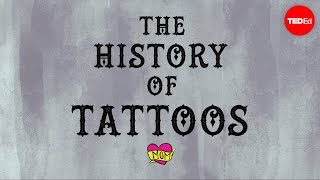(单词翻译:单击)
Thinking of getting a tattoo?
想过刺个文身吗?
Decorating your birthday suit would add another personal story to a history of tattoos stretching back at least 8000 years.
给全裸的身体上来点装饰,能在至少有8000年刺青历史上增添一点个人的故事。
Tattooed mummies from around the world attest to the universality of body modification across the millennia,
世界各地发现的有文身的木乃伊,证明了数千年来文身现象的普遍性,
and to the fact that you really were stuck with it forever if your civilization never got around to inventing laser removal.
这也使人们认识到,如果你所处的文明尚未发明激光移除术,文身会一直留在你身上。
A mummy from the Chinchorro culture in pre-Incan Peru has a mustache tattooed on his upper lip.
来自前印加时期秘鲁克罗文化的一具木乃伊有两撇纹上去的八字胡须。
Otzi, mummified iceman of the Alps,
阿尔卑斯山发现的木乃伊冰人奥茨,
has patterned charcoal tats along his spine, behind his knee and around his ankles,
在脊柱周围、膝盖后面以及脚踝附近都有深灰色的文身,
which might be from an early sort of acupuncture.
这可能是早期某种针灸疗法遗留下的印记。
The mummy of Amunet, a priestess in Middle Kingdom Egypt,
木乃伊阿蒙内特,古埃及中王朝时期的一名女祭司,
features tattoos thought to symbolize sexuality and fertility.
身上也有象征着性欲和生育能力的文身。
Even older than the mummies, figurines of seemingly tattooed people,
甚至比木乃伊的时代还要久远,
and tools possibly used for tattooing date back tens of thousands of years.
貌似带有文身的人的雕像以及可能用来文身的工具几万年前就曾出现。
Tattoos don't have one historical origin point that we know of, but why do we English speakers call them all tattoos?
我们并不知道文身的确切起源时间,但是文身为什么英文里叫“tattoo”呢?
The word is an anglophonic modification of "tatao," a Polynesian word used in Tahiti,
这个单词其实是“tatao”的英文变形,“tatao”是塔希提岛上使用的波利尼西亚语的词汇,
where English captain James Cook landed in 1769 and encountered heavily tattooed men and women.
英国船长詹姆斯·库克在1769年到达该地,看到了布满文身的男男女女。
Stories of Cook's findings and the tattoos his crew acquired cemented our usage of "tattoo"
库克的发现和他船员们身上所刺的文身,使我们开始使用“tattoo”,
over previous words like "scarring," "painting," and "staining," and sparked a craze in Victorian English high society.
取代之前的词语,如“结疤”,“描绘”及“染色”,并使文身在维多利亚女王时代的英国上流社会受到狂热追捧。
We might think of Victorians having Victorian attitudes about such a risque thing,
我们可以推想出当时的人们,对这样一件有伤风化的事情持有维多利亚式的价值观和看法(严谨的行为规范和性约束),
and you can find such sentiments, and even bans, on tattooing throughout history.
类似的看法和文身禁令,在历史上屡见不鲜。
But while publicly some Brits looked down their noses at tattoos,
尽管一些英国人在公共场合对文身嗤之以鼻,
behind closed doors and away from their noses, lots of people had them.
但是私底下很多人都有文身。
Reputedly, Queen Victoria had a tiger fighting a python,
一般认为,维多利亚女王有一个老虎斗蟒的文身,
and tattoos became very popular among Cook's fellow soldiers, who used them to note their travels.
文身在库克的将士们中变得非常流行,他们用文身来记录旅程。
You crossed the Atlantic? Get an anchor. Been south of the Equator? Time for your turtle tat.
你穿越过大西洋?纹个锚。到过南半球?可以纹个海龟了。
But Westerners sported tattoos long before meeting the Samoans and Maori of the South Pacific.
但是西方人文身的历史,远在他们遇见南太平洋的萨莫安人和毛利人之前就开始了。
Crusaders got the Jerusalem Cross so if they died in battle, they'd get a Christian burial.
十字军战士会纹上十字架,如果他们在战斗中牺牲了就会得到基督教式的葬礼。
Roman soldiers on Hadrian's Wall had military tattoos and called the Picts beyond it "Picts," for the pictures painted on them.
在哈德良长城的罗马士兵有军事文身,并且管皮克特人纹到身上的图案叫“皮克特”。
There's also a long tradition of people being tattooed unwillingly.
同样,人们被迫文身也是一个源远流长的传统。
Greeks and Romans tattooed slaves and mercenaries to discourage escape and desertion.
希腊和罗马给奴隶和外国雇佣兵文身以防止逃跑和擅离职守。
Criminals in Japan were tattooed as such as far back as the 7th century.
早在公元七世纪,日本的罪犯就被刺上文身。

Most infamously, the Nazis tattooed numbers on the chest or arms of Jews and other prisoners at the Auschwitz concentration camp
最臭名昭著的,纳粹在奥斯维辛集中营,把数字刻在犹太人和其他被关押人员的胸前和手臂上,
in order to identify stripped corpses.
目的是为了辨认全裸的尸体。
But tattoos forced on prisoners and outcasts can be redefined as people take ownership of that status or history.
但是随着身份和历史的改变,强留在犯人和被遗弃者身上的文身,可以有新的含义。
Primo Levi survived Auschwitz and wore short sleeves to Germany after the war to remind people of the crime his number represented.
普里莫·莱维熬过了奥斯维辛集中营的日子,并在战后穿着短袖来到德国提醒世人不要忘记他的手臂上的数字所代表的那场罪行。
Today, some Holocaust survivors' descendants have their relatives numbers' tattooed on their arms.
如今,一些大屠杀幸存者的后代把亲人的数字纹在自己的手臂上以示纪念。
The Torah has rules against tattoos, but what if you want to make indelible what you feel should never be forgotten?
摩西五经中有条文禁止文身,但是万一有某件事情你觉得永远也不该忘记,需要做些标记呢?
And those criminals and outcasts of Japan, where tattooing was eventually outlawed from the mid-19th century to just after World War II,
在19世纪中期至二战刚刚结束时期的日本,文身是非法的,那时的罪犯和被遗弃者
added decoration to their penal tattoos, with designs borrowed from woodblock prints, popular literature and mythical spirtual iconography.
在他们受刑的文身上,用那些来自版画、畅销文学以及一些神话中的形象进行设计和装点。
Yakuza gangs viewed their outsider tattoos as signs of lifelong loyalty and courage.
日本的黑帮组织把他们异于常人的文身视为终身的忠诚和勇气。
After all, they lasted forever and it really hurt to get them.
毕竟,文身是终身的,而且得到文身的过程也很痛苦。
For the Maori, those tattoos were an accepted mainstream tradition.
对毛利人来说,文身是被主流传统所认可的。
If you shied away from the excruciating chiseling in of your moko design, your unfinished tattoo marked your cowardice.
如果你无法忍受文身过程中刺针进身体的巨大痛苦,那你未完成的文身则象征着你的怯懦。
Today, unless you go the traditional route, your tattoo artist will probably use a tattoo machine
今天,除非你采用传统文身方法,你的文身师极可能是通过文身机器来完成文身,
based on the one patented by Samuel O'Reilly in 1891, itself based on Thomas Edison's stencil machine from 1876.
这种机器是在1891年塞缪尔·奥赖利的一项专利的基础上设计的。而奥赖利的设计则是根据托马斯·爱迪生1876年发明的制版机而来。
But with the incredibly broad history of tattoos giving you so many options, what are you going to get?
文身的历史包罗万象,给你提供众多选择,你会去纹个什么呢?
This is a bold-lined expression of who you are, or you want to appear to be.
这是彰显你是谁或是你希望成为什么样子的大胆表达。
As the naturalist aboard Cook's ship said of the tataoed Tahitians,
正如随库克登船的博物学家讲到带有文身的塔希提人时说,
"Everyone is marked, thus in different parts of his body, according maybe to his humor or different circumstances of his life."
“每个人在身体的不同位置都有文身,这些文身可能按照他的气质绘制,也可能是生命中的不同际遇所致。”
Maybe your particular humor and circumstances suggest getting a symbol of cultural heritage,
也许你独特的气质和际遇使你想有一个符号,或象征文化遗产,
a sign of spirituality, sexual energy, or good old-fashioned avant-garde defiance.
或象征某种精神,或象征性能力,或是象征对过时传统先锋性的大胆藐视。
A reminder of a great accomplishment, or of how you think it would look cool if Hulk Hogan rode a Rhino.
它可以是对伟大成就的纪念,也可以是对你觉得胡克·霍根骑着一头犀牛会有多酷的纪念。
It's your expression, your body, so it's your call.
这是你的自我展示,你的身体,所以这是你的决定。
Just two rules: you have to find a tattooist who won't be ashamed to draw your idea,
只有两条规则:你需要找到个敢于去画出你想法的文身师,
and when in doubt, you can never go wrong with "Mom."
如果有怀疑,纹个“妈妈”总不会错。


